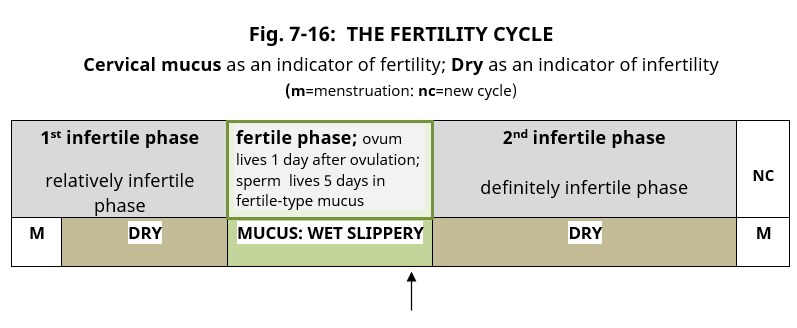The Fertility of the Couple
The fertility of the couple is a shared fertility. The man is always fertile from puberty onwards for the rest of his life. The woman is not always fertile, as the menstrual cycle has a fertile phase which includes ovulation and two infertile phases one of which comes before and one after the fertile phase, (Fig. 7-16). The fertile phase is also called the peri-ovulatory phase as it includes the ovulation event when the ovum (egg) is released into the outer end of the fallopian tube ready for fertilization. (see Pictures & Diagrams, Figs.6-16, 6-17, page 15).
FAB methods of NFP
The Fertility Awareness Based (FAB) methods of Natural Family Planning (NFP) use the natural signs of fertility and infertility that occur in the woman’s body during the fertile and infertile phases of the menstrual cycle, as a method of fertility regulation thus enabling couples to control their fertility without drugs or barriers. These natural signs are called the fertility indicators.
Fertility Awareness
The woman can learn to recognize the changes in her body that signify fertility and infertility.
Fertility awareness is the ability of the woman to identify the fertile and infertile days (phases) of her cycle. The main sign of fertility is the presence of cervical mucus at the vulva, and /or the sensation of moistness or wetness at the vulva. The main sign of infertility is the absence of mucus at the vulva and/or the sensation of dryness at the vulva. The woman learns to keep a daily record of these observations in a chart. (vulva= external opening of the vagina).
Planning a family naturally
By learning to recognise the signs of her fertility (fertility awareness), the couple can time sexual intercourse to plan a pregnancy by using the potentially fertile time of the menstrual cycle or to avoid a pregnancy by using the infertile times of the menstrual cycle.
The Fertility Indicators
The signs of fertility observed by the woman are called the fertility indicators and include:
- changes in the cervical mucus,
- changes in basal body temperature,
- changes in the cervix itself
- and a statistical minor indicator called the ‘Calendar Rule’.
Does it take long to recognise the fertility indicators?
Most women require 2-4 cycles to become familiar with the delineation of the fertile phase.6

Fig. 7-16: The Cervical Mucus as an indicator of fertility; Dry as an indicator of Infertility:
The diagram shows the three phases of the fertility cycle. The relatively infertile phase includes the days of menstruation and the ‘dry’ days that follow the period before the onset of the mucus symptom. The fertile phase includes the ovulation event and is heralded by the build-up of oestrogenic (fertile-type) mucus which indicates a rising oestrogen level from the developing follicle in the ovary and is a sign of potential fertility. The definitely infertile phase after ovulation shows a return to the sensation of dryness at the vulva due to the drying-up action of progesterone from the corpus luteum on the cervical crypts by stimulating the secretion of gestogenic mucus. The definitely infertile phase is so-called, as the woman is definitely infertile in this phase as the ovum is dead and no further ovulation will occur in that cycle, and the gestogenic mucus occludes the cervical canal and prevents sperm entry into the uterus.
When is the fertile phase?
The fertile phase of the cycle occurs around the time a mature ovum is released by the ovary into the fallopian tube (ovulation), ready for fertilisation and includes the six days or so leading up to ovulation. The phases of the menstrual cycle before and after the fertile phase are infertile. According to Freundl4 there are only 6 – 9 days of the menstrual cycle on which intercourse may result in pregnancy. The fertile phase normally occupies not more than one-third of the cycle.3
How can the woman recognize the fertile days?
The woman herself can learn to identify the days when she is potentially fertile by observing the the presence or absence of Cervical Mucus at the vulva, and recording this every day on a chart. She also takes and records daily her Basal Body Temperature (BBT). (see text below).
When do the fertile phase & infertile phases of the cycle begin and end?
In other words – what is natural family planning?
Natural family planning is when the couple apply the RULES of the NFP method they are using to the signs of fertility recorded on the chart in order to define when exactly the fertile and infertile phases of the cycle begin and end. These rules are based on numerous scientific studies done in recent decades by the World Health Organization (WHO) among others.
NOTE: To be most effective, the woman must be taught how to apply the Rules of the Sympto-thermal Double-Check Method of NFP to the fertility indicators by a qualified NFP teacher.
Symptothermal Double-Check Method of NFP
The NFPTAI teach the ‘Symptothermal Double-Check Method‘ of NFP. Our clients learn to apply the RULES of this method to their recorded observations of Cervical Mucus and BBT on the chart and from that the couple can define when exactly the fertile phase begins and ends, and when the infertile phases begin and end.
A brief explanation of what the woman does when she uses the symptothermal double-check method of NFP:
In the Symptothermal double-check method of NFP, the woman takes her temperature each morning and observes a secretion, cervical mucus, which originates in the neck of the womb. The woman records these two signs every day in a special chart, and also records the length of her previous cycles, (the calendar data). These recorded observations enable the couple to determine, day by day during her cycle, whether that day is fertile or not. These observations become routine in a short while, are simple to learn, and women themselves are pleased to know when the fertile time begins and ends.
Natural family planning has two components:
- Fertility awareness with application of the rules of the chosen NFP method.
- Life-style attitude.
1. Fertility Awareness
Fertility awareness is the ability of the woman to identify the fertile and infertile phases of the cycle. Knowing the fertile days of her cycle and by adhering to the rules of their chosen natural family planning method, the couple can abstain from sexual intercourse during the fertile phase to avoid pregnancy, or can use these days for sexual intercourse in order to achieve pregnancy.
2. ‘Life-style’ attitude
The couple may have to adjust their sexual behavior according to their family planning intention. Periodic abstinence, i.e. not having intercourse during the fertile phase, is required if avoiding pregnancy. This requires communication between the couple who learn to show their love in ways other than sexual intercourse during the fertile phase if they wish to avoid pregnancy. Couples who respect their shared fertility in this way find that their relationship is stronger and becomes one of greater respect and consideration for each other. “Respecting one’s fertility cycle demands respect for one’s body, hence respect for the person.”3
Attainment of couple autonomy in NFP involves two phases: (i) correct recognition of the signs of fertility and (ii) they are at ease with periodic abstinence.6 Whatever the motivation, couples using NFP are happy to be in autonomous control of their bodies and their fertility.5
Achieving pregnancy – the effectiveness of NFP
In planning a pregnancy, the couple knowing the fertile phase of the cycle and by adhering to the Rules of their chosen NFP method can time sexual intercourse to the potentially fertile time of the cycle in order to achieve pregnancy1 or abstain from sexual intercourse during the fertile phase if they wish to postpone pregnancy.
Avoiding pregnancy – the effectiveness of NFP
The symptothermal double-check method of natural family planning which is taught by our organization (NFPTAI), is very effective in avoiding pregnancies and in this regard it is as effective as the ‘Pill’ and more effective than barrier methods (e.g. condoms).2 In order to achieve high effectiveness, couples need to be taught the natural family planning rules by a qualified NFP teacher and must adhere to these NFP rules. It is important to note that no method of family planning, whether natural or artificial, is 100%, effective in avoiding pregnancy.
SUMMARY: What is the Fertility Awareness Based (FAB) method of NFP
The Rules of the different FAB methods of NFP define when the fertile and infertile phases of the cycle begin and end. When the rules of the NFP method chosen by the couple are applied to the signs of fertility (cervical mucus & BBT) which are recorded daily on the chart (fertility awareness), we call this natural family planning.
References
- Wilcox AJ, Weinberg CR, Baird DD; ‘Timing of sexual intercourse in relation to ovulation – effects on the probability of conception, survival of the pregnancy, and sex of the baby’; N Engl J Med 1995; 333;1517-21.
- Frank-Hermann et al; ‘The effectiveness of a fertility awareness based method to avoid pregnancy in relation to a couple’s sexual behaviour during the fertile time: a prospective longitudinal study; Human Reproduction, pages 5,7; Feb 2007; p1-10. (on internet)
- Klaus, Hanna; ‘Natural family planning – Is it scientific? Is it effective?’ page 1; Newman Lecture Series 1; May 21, 2000. (online).
- Freundl G et al; “Estimated maximum failure rates of cycle monitors using conception probabilities in the menstrual cycle”; Human Reproduction, (2003), vol 18, no12, p 2628-2633.
- Flynn, A M ; Natural methods of family planning; Clin Obstet Gynaecol; 1984; Dec11 (3); 661-78.
- Klaus H; The Role of the Clinician in natural family planning; J Am Coll Health; 1983; 32(3); 114-120.


